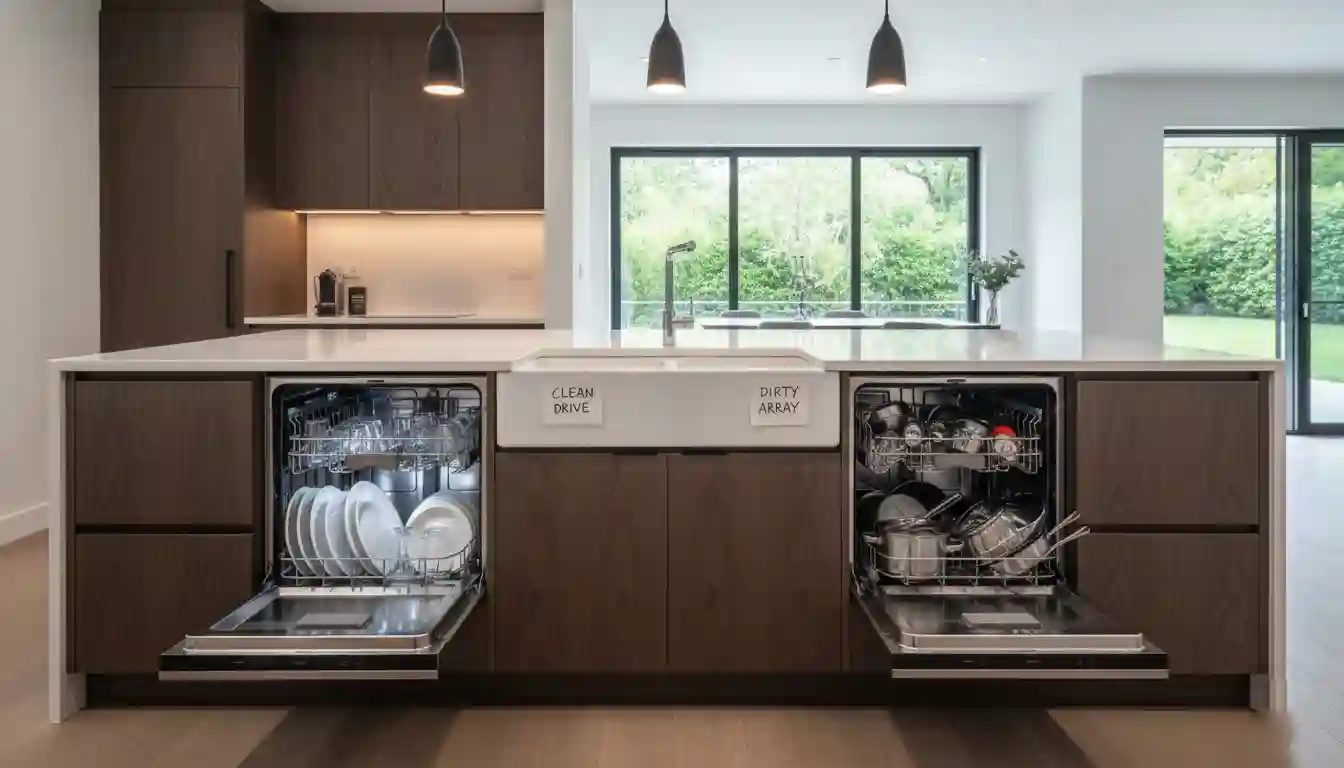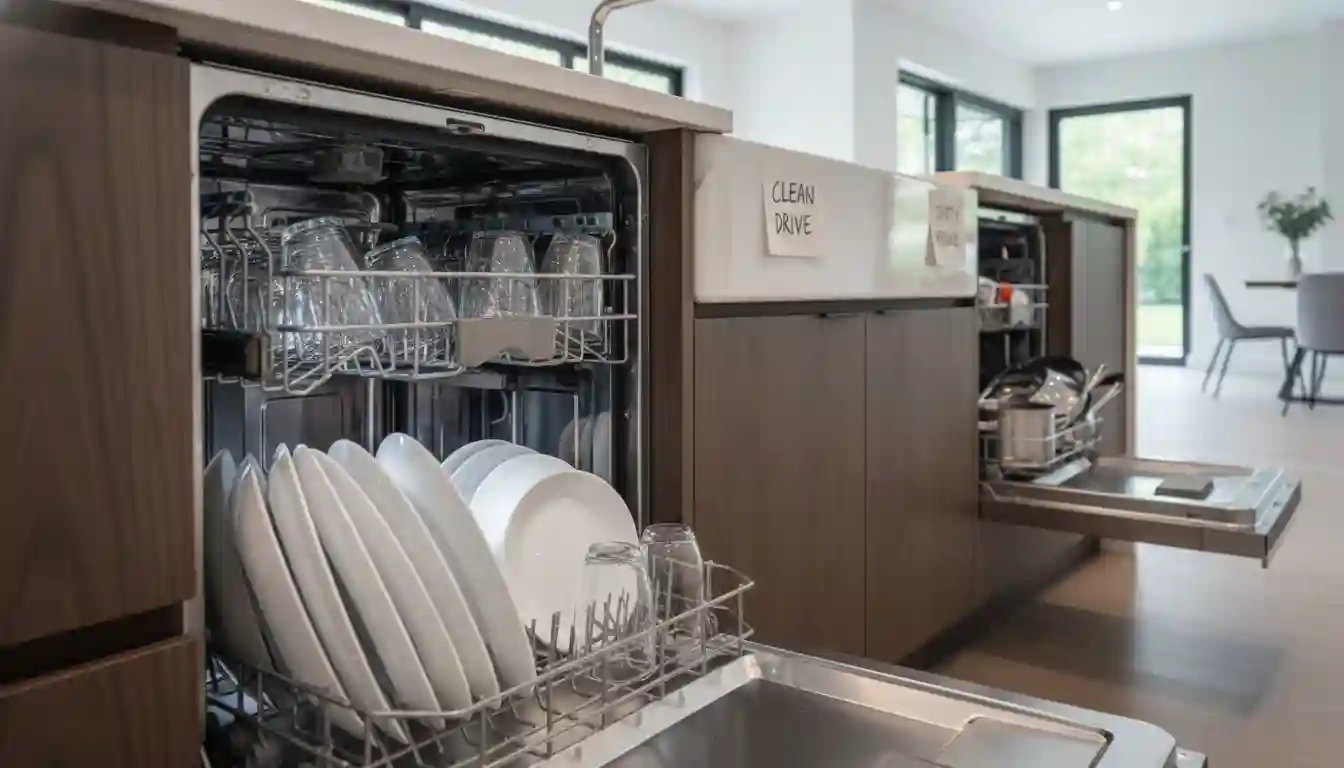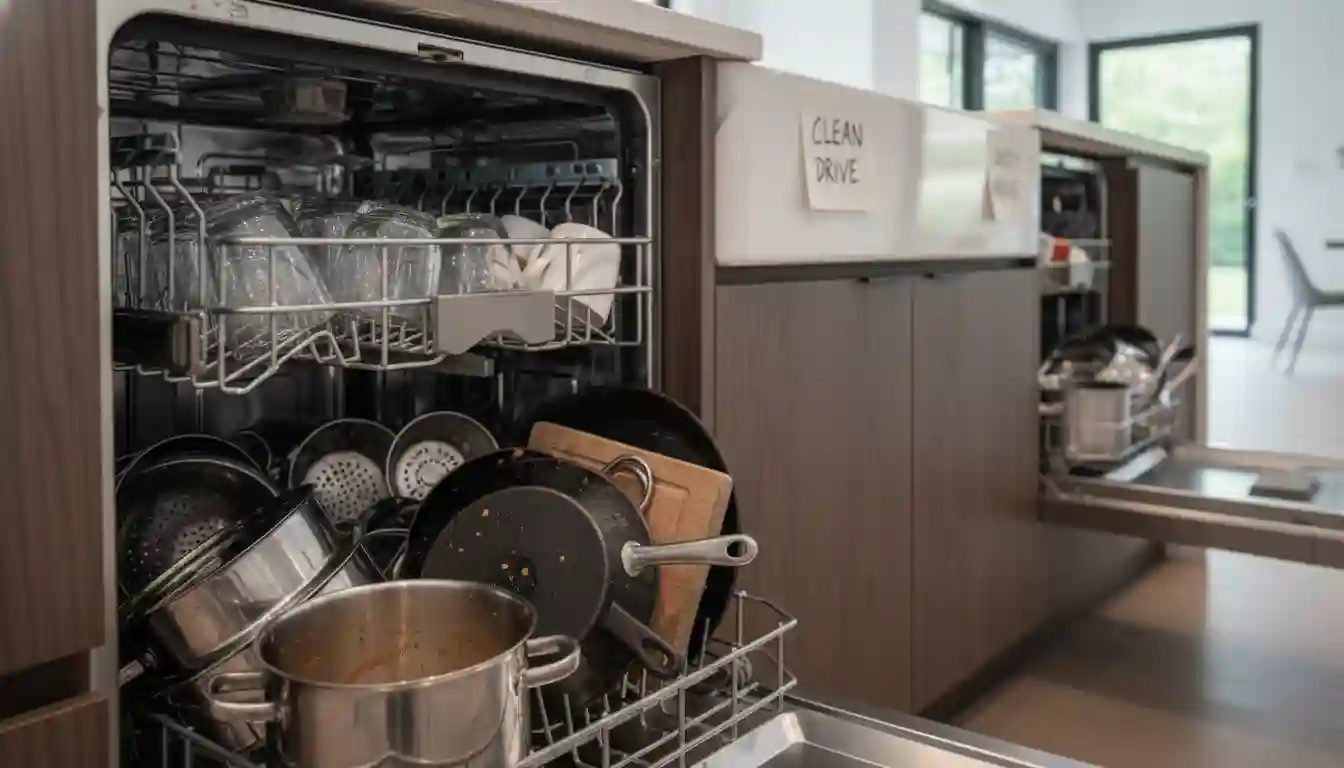Two Dishwashers In Your Kitchen? The Ultimate Guide to a Cleaner Home
Does the sight of a sink overflowing with dirty dishes fill you with dread? For many, especially in busy households, the cycle is endless: you run a full load in the dishwasher only to turn around and find a new pile has already formed on the counter. It’s a constant, frustrating battle to keep the kitchen clean and organized.
What if there was a simple, elegant solution that could eliminate this daily stress for good? Enter the two-dishwasher kitchen. Once considered an over-the-top luxury, installing a second dishwasher is rapidly becoming a practical necessity for large families, avid home cooks, and anyone who loves to entertain.
You'll Learn About
Why Settle for One? The Surprising Benefits of Two Dishwashers
The idea of doubling up on a major appliance might seem excessive at first, but the practical advantages are undeniable. This strategic kitchen upgrade transforms daily routines, turning a point of constant cleanup into a seamless system of efficiency.

End the Never-Ending Cycle of Dirty Dishes
The most significant benefit is the constant availability of an empty dishwasher. With two machines, you can designate one for dirty dishes while the other is running a cleaning cycle. This simple change means no more piling dishes in the sink or on the countertop, keeping your kitchen perpetually clutter-free.
This system ensures that as soon as dishes are used, they have a designated place to go, out of sight and ready to be washed. It transforms kitchen cleanup from a multi-step process into a single, efficient action.
Unprecedented Convenience
For busy families and those who love to entertain, the ability to run two loads of dishes at once is a game-changer. No more waiting for one cycle to finish before starting the next. This means less time spent on clean-up and more time enjoying your home and your guests.
The “Clean” and “Dirty” System
This is the true genius of the two-dishwasher setup. Designate one dishwasher for clean dishes and the other for dirty ones. As you use a clean plate or glass from the “clean” dishwasher, you simply rinse it and place it in the “dirty” one. When the “dirty” dishwasher is full, you run it, and it becomes the new “clean” dishwasher. This system eliminates the need to unload the dishwasher and put dishes away in cabinets, and it keeps your countertops perpetually free of clutter.

Get a closer look at the “clean” dishwasher, full of sparkling dishes, ready to be used or transferred to cabinets.

The “dirty” dishwasher, showcasing the practicality of immediately loading used items, reducing counter clutter.
Perfect for Large Families and Entertaining
For large families, a single dishwasher can quickly become overwhelmed, often requiring multiple loads per day. A second dishwasher effortlessly handles the high volume of plates, glasses, and silverware, making cleanup after big family meals a breeze. When hosting parties or holiday gatherings, two dishwashers are a game-changer, allowing you to clean up as you go without falling behind.
Imagine finishing a large dinner party and having every last dish loaded and washing before you go to bed. That’s the power and convenience that a dual-dishwasher setup provides.
A Cleaner and More Organized Kitchen
A perpetual pile of dishes waiting to be washed can make even the most beautiful kitchen look messy and disorganized. By providing an immediate home for every dirty dish, a two-dishwasher system helps maintain a clean and serene environment. This can be especially valuable in open-concept homes where the kitchen is always on display.
This level of organization reduces visual clutter and the mental stress that comes with it, creating a more peaceful and enjoyable living space.
Specialized Wash Cycles for Different Needs
Having two dishwashers allows you to run different types of loads simultaneously. You can use one machine for a heavy-duty cycle on greasy pots and pans while the other runs a gentle, delicate cycle for fine china and glassware. This not only improves cleaning results but also helps protect your valuable kitchenware from damage.
A Surprisingly Cost-Effective Choice
While the upfront cost of a second dishwasher is a consideration, it can actually be more affordable than you think. In some cases, a second dishwasher can be less expensive than the high-end cabinetry it replaces.
Is the Two-Dishwasher Life Right for You? Key Considerations
Before you commit to doubling your dishwashing capacity, it’s essential to evaluate if this upgrade truly fits your space, budget, and lifestyle. Thoughtful planning is key to ensuring a second dishwasher is a valuable addition and not a costly mistake.
Kitchen Size and Layout
The most crucial factor is space. A standard dishwasher is 24 inches wide, so you’ll need to sacrifice 48 inches of base cabinet space for two units. You must carefully consider your kitchen’s layout to ensure the placement is both functional and aesthetically pleasing. You don’t want the open doors of your dishwashers to block key walkways or create a bottleneck.
Common placements include flanking the main sink, which is ideal for easy rinsing and loading, or placing one in a kitchen island or a butler’s pantry.
Plumbing and Electrical Requirements
Each dishwasher requires its own dedicated plumbing and electrical connections. This means you’ll need separate hot water supply lines, individual drain connections, and a dedicated 15- to 20-amp electrical circuit for each appliance. While it might be tempting to tackle this yourself, the complexity often requires professional help.
Incorrectly installed plumbing can lead to major water damage. If you’re considering the plumbing work, understanding specific components is crucial; for instance, knowing how to stop SharkBite from spinning can be a small but important part of a larger plumbing project.
The Cost Factor: Beyond the Initial Purchase
The total investment goes beyond the price of the second appliance. You must budget for professional installation, potential modifications to your cabinetry, and any necessary plumbing and electrical work. Additionally, running a second dishwasher will have a modest impact on your utility bills over time.
Designing Your Dream Kitchen with Two Dishwashers
Integrating two dishwashers is a design choice that marries high function with modern luxury. Proper planning ensures they blend seamlessly into your kitchen’s workflow and aesthetic.
Popular Placement Configurations
The most common and ergonomic layout is to place a dishwasher on each side of the main kitchen sink. This creates a highly efficient “cleanup zone” for scraping, rinsing, and loading. Alternatively, placing a second unit in a large kitchen island or a nearby prep area can also work well, especially for those who want to separate cleanup zones.
For a truly seamless look, consider panel-ready dishwashers. These models are designed to be fitted with custom cabinet fronts that match the rest of your kitchen, making them virtually invisible when closed.
Choosing the Right Models
While two standard 24-inch dishwashers are a popular choice, they aren’t the only option. Dishwasher drawers offer flexibility, allowing you to run small, independent loads. This is perfect for washing a few glasses or a handful of utensils without waiting for a full-size machine to fill up.
With two appliances potentially running, noise level is a critical consideration. Look for models with a low decibel (dBA) rating, ideally below 45 dBA, to maintain a quiet kitchen environment. An unexpected appliance noise can be disruptive, much like when you hear a high-pitched noise in house every 10 minutes, so choosing quiet models is paramount.

Installation Essentials: Getting It Done Right
Proper installation is non-negotiable for ensuring your dual-dishwasher setup works safely and efficiently. While some aspects may seem straightforward, the combined plumbing and electrical work often requires a professional touch.
DIY vs. Professional Installation
While a seasoned DIYer might handle replacing a single dishwasher, installing two new units is a more complex job. It involves cabinet modifications, running new plumbing lines, and adding a new electrical circuit. Hiring licensed plumbers and electricians is the safest way to ensure the job is done correctly and up to code.
A professional will ensure that both dishwashers drain properly and that the electrical load is safely managed, preventing potential hazards like leaks or electrical faults.
A Step-by-Step Overview of the Process
The installation process follows several key stages. First, the existing cabinetry must be removed or modified to create the necessary 24-inch openings. Next, a plumber will run new water supply and drain lines, often tapping into the main sink’s plumbing. An electrician will then install new, dedicated circuits for each dishwasher.
Finally, the units are slid into place, secured to the countertop, and connected. The process is very similar to a standard appliance hookup, and a guide like one for a dishwasher with top controls installation can provide a good overview of the final steps involved in setting the units.
Maximizing Efficiency: How to Use Your Two Dishwashers Like a Pro
To truly unlock the benefits of your new setup, it helps to adopt a system. The “Always Clean, Always Dirty” method is the most popular and effective strategy for managing your dish flow.
With this approach, one dishwasher is always designated as the “clean” machine, and you unload dishes from it as needed. The other is the “dirty” machine, which you load throughout the day. Once the dirty one is full, you run the cycle, and it becomes the new clean dishwasher, continuing the seamless rotation. This simple habit eliminates the chore of unloading an entire dishwasher at once.
| Feature | Single Dishwasher | Two Dishwashers |
|---|---|---|
| Convenience | Standard; requires waiting for cycles to finish. Dishes often pile up in the sink. | Exceptional; always an empty dishwasher available. Eliminates countertop clutter. |
| Upfront Cost | Cost of one appliance and standard installation. | Cost of two appliances, plus potentially higher installation fees for new plumbing/electrical. |
| Kitchen Space | Requires a 24-inch cabinet space. | Requires 48 inches of cabinet space, reducing storage. |
| Best For | Smaller households, couples, or those with limited kitchen space. | Large families, avid entertainers, Kosher households, and those who prioritize kitchen cleanliness. |
| Resale Value | Standard feature, expected in most homes. | Considered a luxury upgrade that can increase home appeal and potential value. |
The “But”: Potential Downsides and Considerations
-
Upfront Cost: The cost of the second appliance, plus the necessary plumbing and electrical work, can be a significant investment.
-
Space: Not every kitchen has the space to accommodate two dishwashers. You’ll need to sacrifice a 24-inch base cabinet for each full-sized dishwasher.
-
Environmental Impact: While modern dishwashers are more water- and energy-efficient than handwashing, there is an environmental cost associated with the manufacturing and transportation of a second appliance. You can mitigate this by running full loads, skipping the heated dry cycle, and choosing an energy-efficient model.
The “Geeky” Angle: The RAID-5 Dishwasher Setup
For a truly unique way to think about your two-dishwasher kitchen, consider the “RAID-5” analogy. In the world of computers, a RAID-5 setup is a way of storing data across multiple hard drives to protect against a single drive failure. In your kitchen, you can think of your two dishwashers in a similar way:
-
Dishwasher 1 (The “Primary”): This is your main dishwasher, the one you’re currently filling with dirty dishes.
-
Dishwasher 2 (The “Parity Drive”): This dishwasher holds your clean dishes, ready to be used. It’s your “backup,” ensuring that you always have clean dishes on hand.
When Dishwasher 1 is full, you run it, and it becomes the new “parity drive,” while Dishwasher 2 becomes the “primary.” This system ensures a continuous flow of clean dishes and a perpetually clean kitchen. It’s a clever way to describe the efficiency and “redundancy” of a two-dishwasher setup, and it’s a concept that is not widely discussed online.
Frequently Asked Questions About Having Two Dishwashers
Even with the clear benefits, you may still have questions about the practicalities of a dual-dishwasher kitchen. Here are answers to some of the most common inquiries.
Does having two dishwashers increase home value?
While it may not add a specific dollar amount, a dual-dishwasher setup is a significant luxury feature that can make your home more attractive to potential buyers. In a high-end kitchen, it’s an upgrade that signals convenience and thoughtful design, potentially helping your home stand out in the market.
Can two dishwashers share the same drain?
Yes, two dishwashers can typically be connected to the same main sink drain, but it must be done correctly. Each dishwasher’s drain hose should have its own high loop or air gap to prevent backflow of dirty water. A professional plumber can install a “wye” fitting and ensure the drainage system can handle the volume from both units.
Are dishwasher drawers a good alternative?
Dishwasher drawers are an excellent alternative, especially for smaller kitchens or as a supplement to a full-size machine. A double-drawer model provides the same flexibility as two separate units but fits within a standard 24-inch opening. You can run each drawer independently, making them perfect for small, frequent loads.
Ultimately, the decision to install two dishwashers is about investing in a more efficient and less stressful lifestyle. For the right household, it’s a practical luxury that transforms the heart of the home, giving you back valuable time and maintaining a perpetually clean and inviting kitchen.
